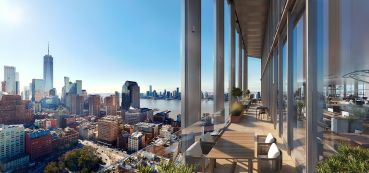Brokers: pop quiz!
What’s one of the most overlooked areas of design that can help you close a deal, realize cost savings on your clients’ behalf and deliver an eye-catching office space that can be easily subleased in the future, should the need arise? I’ll give you a hint: it’s one of the biggest budget items of a build-out, falling right behind HVAC and electrical distribution.
If you answered lighting, you’re among the enlightened. And if you’re surprised by the answer to the quiz, then definitely read on as I run down four of the top lighting trends you ought to know about in commercial real estate today:
Three letters: L-E-D
The top trend in lighting is, without a doubt, the use of light-emitting diode (LED) technology. Why is it so popular? There are several reasons: energy savings that can be realized over time; limited maintenance, as in fewer bulbs to change in the future; and—another “green” benefit—low replacement costs.
LED lighting is often found in featured spaces such as conference rooms and reception areas, rather than in larger, open areas. However, I predict that this will change in the future as incandescent lights and compact fluorescents are phased out in favor of LEDs. The warmth of LEDs and the greater control they give the tenant over lighting levels will make them an increasingly sought-after option in years to come. In addition, as green building becomes more commonplace, the brokerage community and the clients it serves will more fully embrace the technology.
Clustering pendants
For tenants looking to upgrade their space and warm it up easily, clustering fixtures is a simple solution. Lately, we’re designing clusters of pendant lights in conference rooms, above open stairs and in communal spaces. They add a sculptural aesthetic and become a focal point of the design, enhancing the space and taking the place of artwork—a potential cost savings to the tenant.
The light of day
Daylighting is here to stay! Study after study points to the psychological and physiological benefits of daylighting and the increased work force productivity that is a by-product. For instance, a recent study of office workers conducted by the California Energy Commission consistently linked exposure to daylight with higher levels of concentration and better short-term memory recall. With findings like that, it’s no wonder clients are gravitating to the glass!
While utilizing a space’s natural light is nothing new, it can be a major feature for brokers looking to seal the deal. Whether it’s floor-to-ceiling windows or a skylight on an upper floor to make the most of a rooftop, we are helping clients bring in as much light as possible … and all of the views that come with it.
Mix and match
A blend of lighting options is a big trend in commercial architecture today. Gone are the days when a level ceiling called for an evenly lit space. Now we realize that lights can be used for effect as much as function. Ambient light can illuminate work areas, while indirect lighting can highlight design accents. A more varied scope of lighting is typical for today’s tenants and can add to the marketability of an office space.
Incorporating one, or several, of these lighting trends into a design during the programming stage can pay dividends in the long run, saving your clients money and/or time or simply helping them with an exit strategy down the road. Just as resale value is considered on the residential side of the business, those of us on the commercial end should consider the secondary market. After all, a tenant may grow quickly and suddenly need to relocate to a bigger space. On-trend or attention-grabbing lighting can be an important part of what differentiates an office from others on the market. With a little bit of help from an architect and its team of lighting designers (we work with exceptional ones who provide valuable input and top-of-the-line products), brokers can assist their clients in creating attractive—and well-lit—office spaces.


